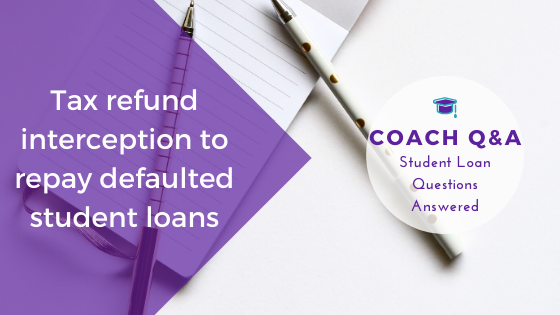I got a notice that my income tax refund is going to be intercepted to repay my defaulted student loans. How can I keep this from happening?
The Department of Education has many tools to collect payment on defaulted student loans. One of the common methods used to collect on defaulted federal student loans is Treasury offset, when part or all of your tax refund is used to pay defaulted loans. Another common method is wage garnishment.
You can file an appeal.
Talk with your student loan holder to appeal your Treasury offset. Your student loan holder is likely a collections company. You can find your current loan holder by logging in to the National Student Loan Data System (NSLDS).
You can appeal your Treasury offset one-time for a financial hardship. However, if you fail to rehabilitate your loan you will not be able to utilize this appeal in the future. You can also appeal if you are currently making payments as agreed with the loan holder.
You need to get your student loans out of default.
There are two options for getting your student loans back into good standing. Treasury offset doesn’t apply to student loans that are in good standing. It’s critical to rehabilitate or consolidate your student loans to prevent future offsets.
Your first option for getting student loans back in good standing is to rehabilitate them. Rehabilitation involves making nine months of on time payments based on your income. After the full nine months is up, your loans will be in good standing and you will need to continue to make the minimum monthly payments until the loan is repaid to keep them in good standing. You won’t have to worry about tax refund interception once your student loans are in good standing.
The downside of rehabilitation is that your income tax refund may still be until the nine months of rehabilitation is complete. It is reasonable to appeal your Treasury offset if you’ve entered into a rehabilitation agreement and made a few months of payments.
Your second option for getting student loans back in good standing is to consolidate them. Consolidation involves applying for a Direct Consolidation Loan. This new loan combines all of your previous defaulted federal student loans into one loan and puts that loan back in good standing. Consolidation takes about one to three months. Payments begin immediately after the loan is consolidated.
The downside of consolidation is that it does not remove the record of default from your credit history. You can’t consolidate your student loans if your wages are actively being garnished.
Additional Resources:
Coach Q&A: How to Rehabilitate or Consolidate Your Defaulted Student Loans




